|
RURU
Barb Rudolf
Barb Rudolf wanted to get into red-point Colorpoint Shorthairs. She
contacted several breeders and finally purchased two red-points from Mrs.
Dolores Balestrieri (Tangee). One, Tangee Girl of RuRu, was kept as a
breeder; the other became Barb’s brother’s pet. One of Tangee Girls
daughters, CH RuRu Tortie Chrisama (Kissy), was a tortie point who
absolutely captured the heart of a dear friend of Barb’s named Jane
Braden (Llyr cattery). Jane wanted so badly to produce red Orientals. She
had a male Oriental named Cormac (Llyr Cormac Mac Art) who was registered
as red tabby; but had proven to be cream. Jane said that Barbara was going
to breed Kissy to Cormac or else. Barb said, “I do not want to breed
Orientals.” Jane said “yes you will” and Barb said “no, never, I
will not breed Orientals!” So the breeding was done and Kissy had five
kittens on March 6th, 1980.* Two, a cream spotted tabby
Oriental named RuRu ChrismMac and a cream spotted tabby female named RuRu
Cinnabar,* Barb kept for breeding. Jane kept a blue cream female RuRu
Deidre of Llyr.* Barbara Rudolf had to admit that she really liked
Orientals.
Cinnabar was bred to a Siamese owned by Chris Jones and named CH Star of
Siam’s Kelii of Tamman, out of GRC Thaibok Tyrone and GRC Star of
Siam’s Leila. This breeding produced a tortie female named RuRu Epris.*
Barb says that Epris had an awful head but a fabulous body. At a show in
St. Louis Mary Stewart who had some lovely chestnut Oriental males with
her, came by to look at Epris. She said that Epris had the most wonderful
body she had ever felt on an Oriental, and for that alone she deserved to
grand. So Epris was kept out, and she defeated cats with better heads
often enough to keep going. Finally, Mary Stewart saw her again, this time
as a judge, she finaled her and that granded the cat! The next year Epris
was the best
OSH
in the MWR. Mary also suggested a breeding. She had sold one of her lovely
males CH/GRP Lepracan Mus Brown Is The Color, but called Spyder to Lynn
Fairbanks, who was going to show him in premiership. So Barb called
Lynn
and asked for a stud service.
Lynn
was willing but only for a one shot deal. The day after Epris was bred
Spyder was neutered. Interestingly, Spyder’s grandmother was NGRC
Patapaw Firefly. Although Spyder was not red he had a great blue-cream
behind him.
Fortunately Epris was pregnant and had seven kittens in assorted colors.
One was a red spotted tabby with outstanding type and he was named RuRu
Red Spreeder.* Jane was getting out of cats so she made Barb promise to
keep her red Orientals going. Spreeder made it very easy to keep that
promise. He did very well as a kitten then finaled in five out of six
rings as an open, with several best cat wins, and granded in two shows at
the age of 8 ½ months. Altogether he was only shown in eleven shows as an
adult, all in the
Midwest
region. From this he was: the first red tabby Oriental grand, Best Midwest
Region OSH 1983-84, and
Midwest
19th best cat. To add icing to the cake, he has proven himself
to be a great breeder even though he has only been used in a limited
fashion. His grand offspring include: GRC RuRu Red Encore, red ticked
tabby male. GRC Ruru’s Sugar Foot of Lumax, tortoiseshell female. GRC
RuRu’s Lavender O Mega Spots, lavender spotted tabby male. GRC
Printer’s Dromineer,* ebony male. GRC Kaybill’s Gingersnap of Kulta,
ebony patched tabby female.
In spite of Spreeders’ limited stud services he has wound up to be
behind a huge number of lovely cats in s lot of different catteries
including: Wintara, Pegela (Elaine and Peggy Rands), Colormagic (Pamela
and Gary Huggins), Kulta (Joanne Kultala), Kaybill (K. Wentling), Wolfs,
Kaliman, Cerissa, JandJ, Manalishi, in West Germany, Argentina and France
as well as others probably unknown. The common theme is, of course, the
vivid red color that Spreeder produces. Barbara says that to keep her
promise to Jane (now Rhyes) she will have to do better than that, she
needs better ears (don’t we all) and a longer head to make that perfect
cat. And what color does Barb’s perfect cat come in? You guessed it,
vivid, brilliant RED.
At first thought it is surprising that only one
OSH
kitten has placed in CFA’s top ten kittens. Oriental kittens are often
present in kitten finals, even if they are rarely best kitten. The
difference between finaling and finaling high is enormous. In a random
sample of 34 shows in one month in early 1990, representing shows from all
over the country, an interesting pattern showed up in kitten finals. 35
Oriental kittens finaled at least once in these 34 shows, but only once
was an
OSH
the highest scoring kitten in show. In 22 of these 34 shows a Persian
kitten was the highest scoring kitten in show. Of the other twelve Best
kittens only a single Burmese and one Scottish Fold kitten captured
highest scoring kitten twice. The remaining ten spots were won by ten
different kittens of ten different breeds. One was an Oriental Shorthair.
Why is this? Aside from the inherent appeal of a furry and typey Persian
kitten, there is the fact that a kitten must live up to an adult standard.
The Oriental standard calls from a fine boned at with large ears, which is
fairly easy for a kitten to achieve. The standard also requires that the
cat have a long head, a straight profile and surprisingly heavy and
muscular body for its long, slender and tubular appearance and that is
rather harder for a kitten to be. One oriental kitten did manage a top ten
win and here is the story behind her as told by her breeders and owner
Robert and Sharon Gummow.
PURTEECATS
Robert and Sharon Gummow
Sharon and I started breeding cats about six years ago. We had pet Siamese
for years and after they had passed away, Sue Hoffman Bush (Sujym)
introduced us to Orientals. We ended up buying a breeder from her, a solid
lavender Sujym Oriental Lace of Purteecats, who is the mother of GRC
Purteecats Liberty Belle*
(sired by San-Toi Crackerjax of Purteecats). Belle, also a lavender, was 2nd
best kitten in the top twenty as an adult in the Great Lakes Region, and
Best Oriental at the CFA / Purina Invitational Show in 1988-89.
We decided to concentrate on solid color Orientals in the four basic
colors, as well as seal point and blue point Siamese. We have used San-Toi,
Sujym, Nefrtt, Blkcyn, Felitan, Seareef, Fan-C, and Windflower lines in
our breeding program. We have a fairly small cattery and concentrate on a
small number of quality breedings.
In 1987-88 we bred and showed National Winner GRC Purteecats Elvira.* She
was the first Purteecats Grand. Elvira, an ebony, was out of our GRC
Blkcyn
Kenya
of Purteecats and was sired by GRC Nefrtt’s Blue Scarab if Galari. The
breeding was not without problems. Gretchen Flesher offered to let us use
Blue Scarab the first time that she saw
Kenya
. It was his first outside stud service.
Kenya
developed a vaginal infection after the breeding and ended up receiving
prostaglandin treatment in an attempt to save her for breeding. After two
more breedings, she finally successfully conceived and had a litter of six
healthy kittens. Elvira was the pick female.
Elvira was shown six or seven shows before w even thought about the
possibility of a national kitten win. All but two of her shows were within
four hours driving time of our
Toledo
,
Ohio
home. Al and Jan Garraputa, Debbie Missotti, and Gretchen all were helpful
in giving us pointers and helping us pick shows after we decided to go for
the win. Elvira ended her kitten career with 2277 points in November 1987
and was in 6th r 7th place at that time. We had to
sweat out the next four and a half months, watching her drop to tenth
place, where she stayed. That year she was not only 10th best
kitten nationally, but also GLR Best kitten and 11th best cat.
One attribute that is essential for a top show Oriental is the
proper ear set. Ears are only worth 5 points according to the breed
standard, but in fact they make, or break, the whole front look of the
cat. A judge looks hard at all the Orientals in a class, and that can be
quite a few cats. After making mental notes about the better cats in the
class, he or she turns around for a last look to make a final decision.
Unless there is a real stand out in the class, the final decision gets
made in that last look. We’ve all been there watching the judges
hesitating between the best three or four cats, while hoping the brown
ribbon will land on our cat’s cage. When the judge wiggles a feather and
OOPS! Up go the ears and the best of breed goes to that other cat whose
ears stayed down in the wedge. One pair of breeders who seem to be able to
avoid the floating ears problem with the greatest of ease is Dee Johnson
and Connie Roberts of San-Toi cattery.
|
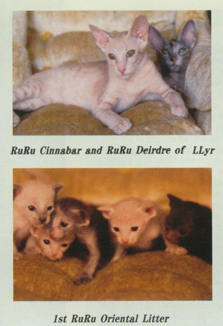
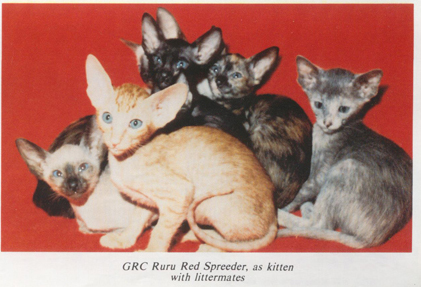
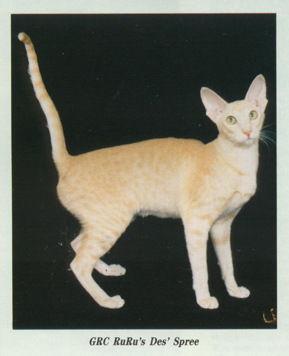

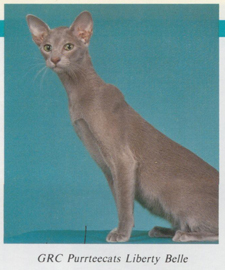
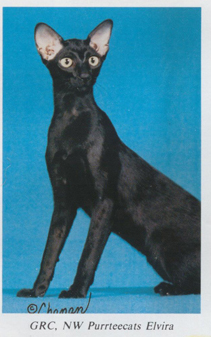
|


